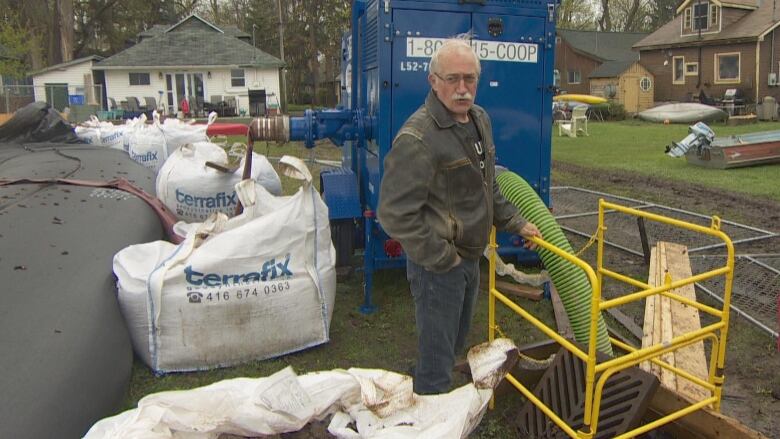Lessons learned: Ward's Island residents get ready for possible flooding
If Lake Ontario reaches 2017 levels, island residents say they're ready

There aremassive sandbags lining the shore, the ground is cold and soaked, and there's already five centimetres of water in his crawl space, but Mike French doesn'tseemed worried that Ward's Island could flood all over again.
"I would say we're cautious, we're ready this time," said French, who has lived on the island for about a decade.
"We're watching now where vulnerable points are and we've started sandbagging."
French is part of an emergency preparedness committee that monitors water levelsand updates residents on flood mitigation efforts.

The city is under a "shoreline hazard warning" that was issued earlier this month. Lake Ontario is approaching water levelsthat were last seen in 2017, when floodwaters inundated the islands for months and forced the closure of Toronto Island Park for much of the summer.
This time around, when residents heard about the increase, they took to sandbagging and the city brought in an inflatable dam.
New infrastructure put in
But French saysthe early response is only part of what's going to save people's homes. The other factoris the permanent changes that have been made to the island's infrastructure.
Holes were dug to install nine concrete cisterns. They're covered bygrates and collect any excess surface water.
"We still might get some pooling in low points, but we now have these pumps where they can just drop in and shoot the water quickly out into the lake," said French.
-
Still underwater, Toronto Islands prep for a different kind of summer
-
Ontario cuts conservation authority funding for flood programs
Island won't close during flood
Water levels are sitting about 20 centimetres shy of what they were in 2017.Still, city spokesperson Brad Ross says it's unlikely they'll have to close the island if water levels surpass that.
"The other thing we did in the two years is rebuildthe docks for the ferries," said Ross.
"Two years ago, the ferries couldn't go to the island, that's why we had to close the island. This time around, the ferry docks are able to accept the ferries. So we don't foresee having to close the island."
Another lesson learned is that the city, island residents, and the Toronto Region Conservation Authority are working together to deal with the situation.

The TRCA helped with a risk assessment on the island right after the flooding and is now providing assistance with placing larger-size sandbagsthroughout the island.
Rehana Rajabali, senior manager for TRCA's flood risk management division, says they're monitoring the lake.
"The typical time for Lake Ontario levels to peak is late May or early June. Now, whether or not they get to those 2017 peaks or notreally depends on the precipitation in the coming days. Not just in our watershed,but what's also happening in the Ottawa River basin," said Rajabali.
As for French, he says he's ready for the worst of it. Last time, he lost manyfamily photos when his crawl space flooded. This time, he's already removed the boxes.












_(720p).jpg)


 OFFICIAL HD MUSIC VIDEO.jpg)
.jpg)



























































































